► First look at solar-powered production car
► ‘70 miles of solar driving a week‘
► Plus we drive an early prototype
Here’s a new car start-up you probably haven’t heard of before – but one that should capture your attention. Sono Motors is a Munich-based EV wannabe that’s hoping to disrupt the automotive mainstream with a novel solar-powered electric car, the Sion with a remarkably low price.
The production version of the Sono Motors Sion was unveiled overnight at the sustainability specialist’s Celebrate The Sun event in Germany. It’s noteworthy on various levels:
- It’s claimed to be the ‘world’s first Solar Electric Vehicle (SEV) for the masses’
- 54kWh battery topped up by sun for ‘free’ 70 miles of solar driving a week
- 19,000 customer deposits already taken
- It seemingly reintroduces the MPV monobox bodystyle… a genre being abandoned by mainstream makers
Revealed: the cheapest electric cars
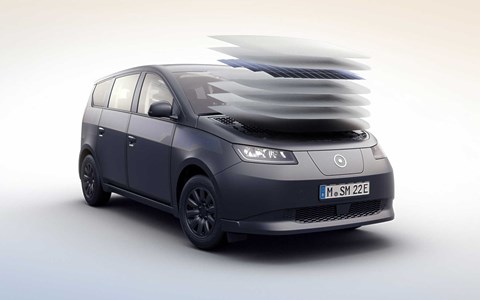
It’s important to note that owners will still charge the Sono at a regular EV charging point; even the sunniest climes cannot produce the electricity required to fully boost the 54kWh LFP battery. But the brightest environment could boost that weekly solar kick to 150 miles of free range.
Charging capacity is 75kW on a fast DC charger, 11kW on AC home-charging. Bidirectional charging technology has been confirmed, meaning that the Sono can act as a power supply at home, yielding up to 11kW to fuel home gadgets.
Prices for the Sono have been announced: €25,126 in its German domestic market, equivalent to £21,300. That’s a breakthrough for cheap electric cars, if this car does indeed launch at that price. No wonder more than 19,000 customers have signed up already, each placing a £1900 deposit.
The Sono Motors Sion is now entering validation prototype test phase ahead of a series production launch planned in the second half of 2023. Valmet Automotive is Finland is contracted to manufacture the solar car, with upto 257,000 annual production by 2030. Bold claims indeed!
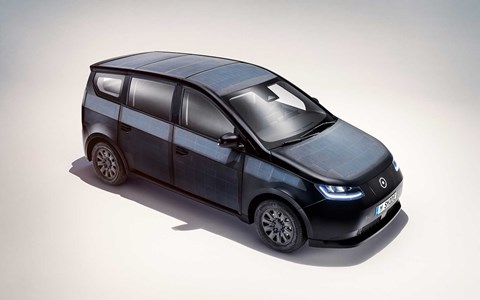
Read on to find out what the Sono is like to drive, after our European editor Georg Kacher got behind the wheel of a prototype.
Sono Motors: the background
Like the Sion by Sono Motors, Ford’s Model T was available only in black, extras were non-existent, and the same money would at best buy less intriguing alternatives like a couple of tired horses. But unlike Henry Ford, who had created several different motor cars before hitting the bullseye with the Model T, Laurin Hahn – founder of Sono – only just graduated from university. And unlike the Model T, the Sion is an electric car that gets much of its charge from super-efficient solar panels.
Aged 26, Hahn is an environmentalist, non-conformist and idealist. ‘It’s not our goal to sell as many vehicles as possible,’ he says, ‘but to implement an innovative CO2-neutral mobility concept.’ The first car born out of this ideal is the Sion, a matt black neo-MPV.
The earlier prototype (below) has been adapted for the final production run, with its design packing in new headlamps and door handles and a smoother bodyshell for superior aerodynamics and better packaging of the solar panels.
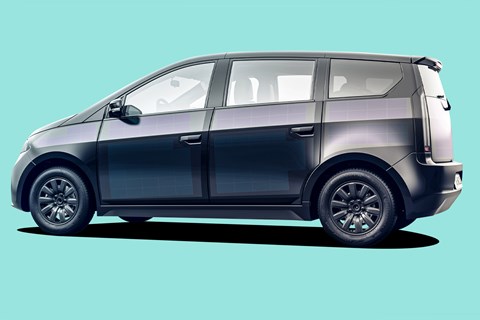
Located in one of the few remaining working-class outskirts of Munich, the not-so-grand Sono House is a converted and hastily renovated workshop which had a couple of buckets of white paint thrown at it hours before the opening. Two cars are parked inside the vast single-room facility – the very first mule and the latest iteration towards the finished product. Clean and complete, it’s nonetheless a rough-looking thing with third-world window seals, doors that may never align with the rest of the body and a coal-mine surface finish.
By the time it goes into production and becomes available throughout the EU, which is a couple of years away, expect that fit and finish to improve. But it will still be a low-budget product, with no premium aspirations.
It’s a simple but effective car
Hahn, his sales chief Thomas Hausch (ex Mercedes, Chrysler, Nissan) and the team seem oddly at ease with the provisional nature of the demo car. But their confidence makes sense when we drive it.
Minutes later, we’re four up in this stealthy cubist people mover, peeling tarmac from a series of service roads; think of it as a kart track without cones, kerbs and a defined start/finish line. Why not go on the open road? Because type approval is still months away, and there are some insurance issues in need of clarification. Never mind. On a playground the size of six tennis courts, the Sion wastes no time in impressing the driver and silencing the passengers.
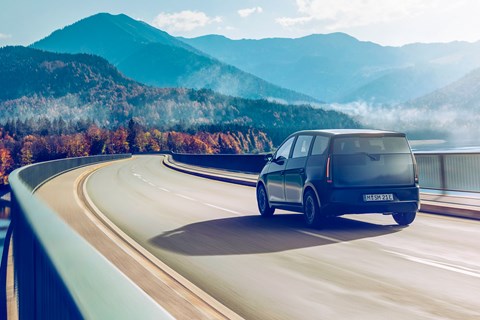
First impressions from this short drive: the Sion accelerates, changes direction, brakes and comes to a stop perfectly competently. Even when pushed, it does not shed bits and pieces, remains quiet bar the meowing outside-front tyre, and feels quick despite all the bulk and weight. The cabin is quite spacious, the boot is vast and the controls are spot-on in terms of effort and response, while the 161bhp e-motor mated to a single-speed transmission is revving for its life.
The dashboard features two busy displays, but what catches the eye in this mostly-black cabin is the backlit bright green Irish moss, which spreads behind glass the full width of the lower instrument panel. Unlike leather-clad EV luxury liners, the Sion actually comes across as credible planet saver. Why? Because it minimises the use of raw materials in the beginning rather than maximising the recycling effort at the end.
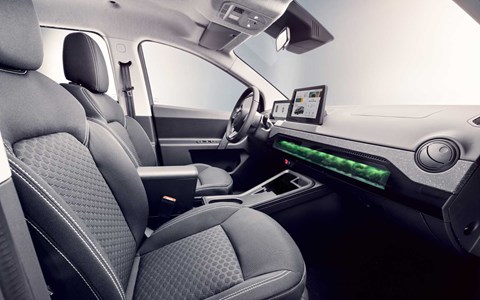
The cabin has been improved for production, too, packing more storage space, newly designed front seats and a different steering wheel.
It’s had users in mind from the start
A community of supporters was instrumental in shaping the car. Over 15,000 participants voted for black over white, chose durable upholstery and even the no-nonsense design of the wallbox. They signed off on 400 volts, accepted a real-time range of 190 miles and okayed the performance numbers (0-62mph in around 9.0sec, 87mph top speed).
Maintenance will be by independent service partners or on a factory-supported DIY basis, the 54kWh batteries are fully warrantied off-the-shelf items, and the maximum power of 75kW indicates a five to 80 per cent charging time of 35 minutes.
Sono has even devised a clever car-sharing service. Disciples connect via a bespoke app which also masterminds payments, insurance and the integration of personalised telematics. Options include straightforward renting, car-pooling and ride-sharing.
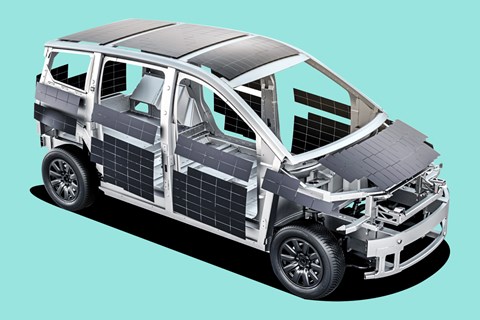
Where exactly do the 456 solar panels enter the equation? Thomas Hausch summons the bird’s-eye view of the car on the centre display to show the contribution of the energy-absorbing skin to the state of charge: ‘In summer, the panels can help to more than triple the range to 625 miles. Parked in a sunny spot, the Sion will, in a week, pick up enough solar power for an extra 150 miles.’ Or, put another way, 20-odd miles a day: handy.
If all goes according to plan, each vehicle will attract 12 users on average, thereby reducing the running costs per person by 85 per cent while boosting the use of each car by up to 150 per cent. Come 2025, this strategy is expected to generate an annual turnover of €295m (£250m). Additional income will be sourced from the patented solar panels, which can also be used for boats, trucks, trains and camper vans.
‘Our bespoke cells are two-thirds lighter than glass,’ boasts a beaming Hausch. ‘The unique polymer coating is an excellent protection against wear and tear. In case of an impact, there is no splintering, only a dent or a ding. Furthermore, our concept offers significant cost benefits thanks to the much shorter 30-second production cycle which compares favourably to the 20 minutes quoted by suppliers of conventional hardware. Add to this a four-times higher efficiency, and the result is a water-tight business case.’
The Sion offers a completely new proposition. Will it catch on, and will the sharing scheme appeal to enough people? Based on what we know so far about Sono and the ambitious Sion, the technology provides very sturdy foundations.
Further electric car reading
The best EVs on sale today
Longest range electric cars
How much does it cost to charge an electric car?